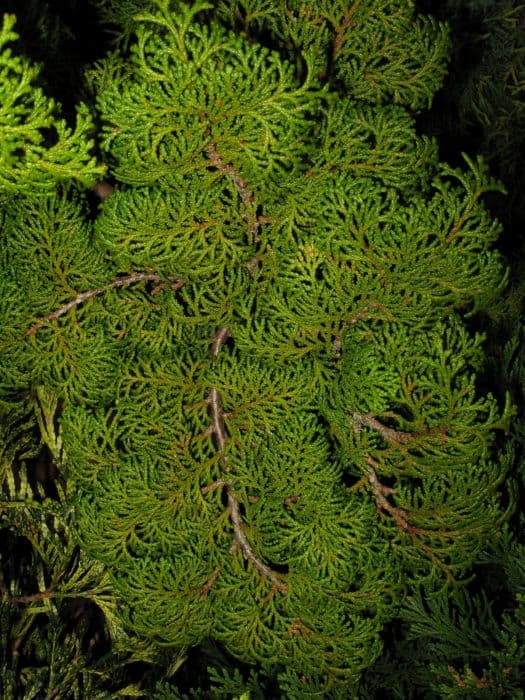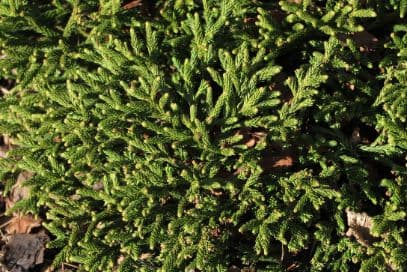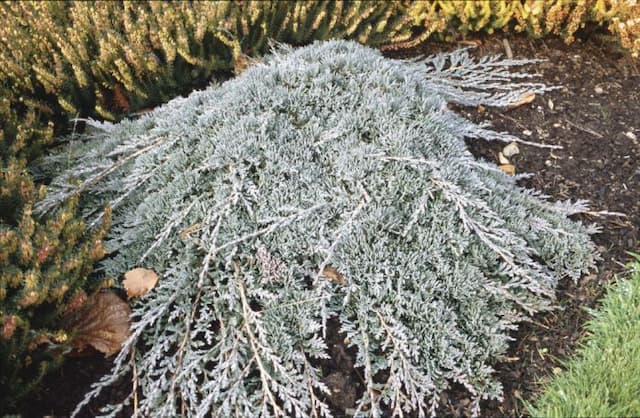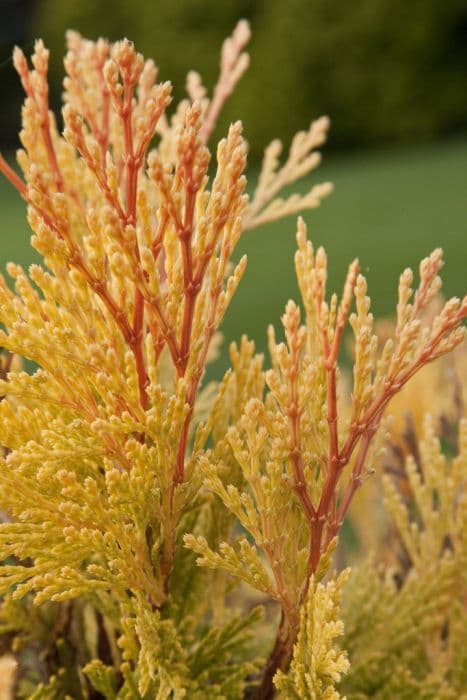Japanese Cedar Cryptomeria japonica

ABOUT
Cryptomeria japonica, commonly known as Japanese cedar, has a distinct appearance characterized by dense, blue-green foliage that forms in spirals around the branches, creating a texture that is both feathery and visually soothing. The leaves of the Japanese cedar are awl-shaped and sharply pointed, resembling needles which can be about 0.5 to 1 inch long. The plant's soft and flexible needles take on a slight bronze coloration during cold weather, adding seasonal interest. The bark of the Japanese cedar is reddish-brown and has a shredded texture, which often peels away in vertical strips, revealing a somewhat furrowed and interesting pattern on the trunk and branches. The bark's unique texture and color provide an appealing contrast to the lush foliage. The Japanese cedar produces small, globular cones that are about 0.5 to 1 inch in diameter. These cones are a brownish color and have a bumpy surface texture with scales. They add to the ornamental value of the tree, especially when they stand out against the dense foliage. Overall, the Japanese cedar is an evergreen that exudes a sense of majesty and elegance, making it a beloved ornamental plant in many gardens and landscapes. Its texture, foliage color, attractive bark, and ornamental cones all contribute to its distinctive appearance.
About this plant
 Names
NamesFamily
Cupressaceae.
Synonyms
Japanese Cedar, Sugi, Jomon Sugi, Japanese Redwood.
Common names
Cupressus japonica, Schubertia japonica, Taxodium japonicum, Thuja japonica, Cryptomeria araucarioides, Cryptomeria compacta, Cryptomeria elegans, Cryptomeria fortunei, Cryptomeria generalis, Cryptomeria kawaii, Cryptomeria lobbii, Cryptomeria mairei, Cryptomeria nana, Cryptomeria spiralis, Schubertia araucarioides, Schubertia sinensis, Cryptomeria japonica var. radicans, Cryptomeria japonica var. sinensis.
 Toxicity
ToxicityTo humans
Japanese cedar is not known to be toxic to humans if ingested. There is no significant evidence to indicate that any part of the plant poses a poisoning risk if consumed. However, as with any plant material, individual allergies or sensitivities may exist, and it's always prudent to avoid eating plants not generally recognized as food sources.
To pets
Japanese cedar is not considered toxic to pets if ingested. It doesn't contain any known toxins that are harmful to common household pets such as dogs and cats. As with humans, the general rule of thumb is that pets should not consume plants that are not part of their typical diet, but ingestion of Japanese cedar is not expected to cause poisoning symptoms or serious health consequences. However, pets may have varying sensitivities, and ingestion could potentially cause mild gastrointestinal upset in some animals.
 Characteristics
CharacteristicsLife cycle
Perennials
Foliage type
Evergreen
Color of leaves
Green
Height
50-60 feet (15-18 meters)
Spread
20-30 feet (6-9 meters)
Plant type
Tree
Hardiness zones
5-9
Native area
Japan
Benefits
 General Benefits
General Benefits- Landscape Aesthetics: With its pyramidal shape and dense foliage, Cryptomeria japonica, commonly known as Japanese cedar, adds a striking visual element to gardens and landscapes.
- Shade Provider: It can provide ample shade due to its tall and broad growth habit, making it an excellent choice for parks and large gardens.
- Timber Production: The wood of Japanese cedar is valued for its lightweight, resistance to rot, and is widely used in construction, carpentry, and cabinetry.
- Habitat for Wildlife: This tree serves as a habitat and food source for various birds and insects, contributing to biodiversity.
- Noise Barrier: The dense growth of Japanese cedar can help in reducing noise pollution when planted in rows or as part of a hedge.
- Windbreak: It is often used as a windbreak to shelter homes and crops from strong winds, thereby reducing erosion and property damage.
- Soil Improvement: Japanese cedar can help in soil stabilization with its extensive root system, thereby preventing landslides and soil erosion.
- Cultural and Historical Significance: In Japan, Cryptomeria japonica holds cultural importance and is often planted around temples and shrines, contributing to the cultural landscape.
 Medical Properties
Medical Properties- Anti-inflammatory: Compounds in Cryptomeria japonica exhibit anti-inflammatory effects.
- Allergenic: Pollen from Cryptomeria japonica can cause allergic reactions in sensitive individuals, which in turn has led to study of its allergenic components for understanding and treatment of allergies.
- Antioxidant: Extracts of Cryptomeria japonica may display antioxidant properties, helping to remove free radicals from the body.
 Air-purifying Qualities
Air-purifying QualitiesThis plant is not specifically known for air purifying qualities.
 Other Uses
Other Uses- Cryptomeria japonica, commonly known as Japanese cedar, is utilized in bonsai cultivation. Enthusiasts prune and shape these trees into miniature versions that mimic aged, natural trees.
- Japanese cedar wood shavings are used in the production of traditional Japanese incense, contributing a distinct woody aroma.
- The lightweight, yet strong wood of the Japanese cedar is fashioned into traditional geta sandals, which are a form of Japanese footwear.
- In Japan, the wood is often used for making sake barrels, which are believed to impart a unique flavor to the sake during the fermentation process.
- Timber from Japanese cedar is used in traditional Japanese construction, including building Shinto shrines and temples, because of its resistance to rot.
- The sawdust and wood scraps of Japanese cedar can be compressed into pellets for use as a renewable biomass fuel for heating.
- Japanese cedar is often planted as a windbreak tree in agricultural settings, helping to protect crops from wind damage.
- Due to its resistance to water, Japanese cedar is used for crafting wooden hot tubs and baths known as 'ofuro' in Japan.
- The fine-grain texture of Japanese cedar wood makes it an excellent material for crafting musical instruments such as drums and koto.
- Foliage from the Japanese cedar can be used as a natural dye for fabrics, imparting a brownish color when properly treated.
Interesting Facts
 Feng Shui
Feng ShuiThe Japanese cedar is not used in Feng Shui practice.
 Zodiac Sign Compitability
Zodiac Sign CompitabilityThe Japanese cedar is not used in astrology practice.
 Plant Symbolism
Plant Symbolism- Longevity: Cryptomeria japonica, commonly known as Japanese cedar, is an evergreen tree that has a long lifespan. This makes it a symbol of longevity and enduring life.
- Sacredness: In Japan, the Japanese cedar is often planted around temples and shrines, indicating its sacred nature and connection with the divine.
- Eternal: Because it is an evergreen and retains its foliage throughout the year, it is seen as a symbol of eternity and immortality.
- Strength: Japanese cedar has a robust and sturdy trunk, which symbolizes strength and resilience.
- Peace: The tree's towering and serene presence in landscapes symbolizes peace and tranquility.
 Water
WaterThe Japanese Cedar should be watered deeply and thoroughly, ensuring the soil is moist but not waterlogged. For established trees in the ground, watering should be done every few weeks, with about 1.5 to 2.5 gallons per watering session, depending on the weather conditions and soil type. During the hot, dry summer months, the frequency should increase to once a week or as needed if the soil begins to dry out. Less watering is required during the rainy season or cooler months. Always allow the top few inches of soil to dry out before watering again to prevent root rot.
 Light
LightThe Japanese Cedar thrives best in full sunlight to partial shade. It should be planted or placed in a location where it receives at least six hours of direct sunlight daily. While the tree can tolerate some shade, too much will affect its growth and foliage density. An ideal spot would be an open area away from larger trees or buildings that could cast too much shadow over the Japanese Cedar.
 Temperature
TemperatureThe Japanese Cedar is hardy and can tolerate a wide range of temperatures. It can survive in conditions as cold as -20°F and as hot as 100°F. However, the ideal temperature range for the Japanese Cedar is between 50°F and 75°F. Sudden extreme temperature fluctuations should be avoided to maintain the health of the tree.
 Pruning
PruningThe Japanese Cedar should be pruned to maintain shape, remove damaged or diseased limbs, and encourage healthy growth. The best time for pruning is late winter or early spring before the new growth starts. Prune sparingly, as heavy pruning can harm the tree. It is generally recommended to limit pruning to once a year or only when necessary to correct growth issues.
 Cleaning
CleaningAs needed
 Soil
SoilJapanese Cedar thrives in moist, well-draining soil with high organic content. The ideal soil pH should be slightly acidic to neutral, ranging from 5.0 to 7.0. A mix of loam, peat, and coarse sand is often recommended to ensure proper drainage and fertility.
 Repotting
RepottingJapanese Cedar, being a slow-growing conifer, does not require frequent repotting. Young trees should be repotted every 2-3 years, while mature trees can be repotted less frequently, every 4-5 years, to refresh the soil.
 Humidity & Misting
Humidity & MistingJapanese Cedar prefers a humid environment, which mimics its natural habitat. The best humidity level for the plant is around 50-60%, which will help to keep the foliage healthy and prevent browning of the needle tips.
 Suitable locations
Suitable locationsIndoor
Ensure bright, indirect light and high humidity for Japanese Cedar.
Outdoor
Plant in full sun to partial shade, in well-drained soil for Japanese Cedar.
Hardiness zone
5-9 USDA
 Life cycle
Life cycleJapanese Cedar begins its life cycle with seed germination, which occurs after seeds are dispersed and settle in a suitable environment with adequate moisture and warmth. The resulting seedling goes through a juvenile phase where it establishes roots and foliage, growing into a sapling. As it matures into an adult tree, it develops reproductive structures; male cones release pollen while female cones become receptive to fertilization. Pollination is followed by fertilization which leads to the development of seeds within the female cones. Once mature, these seeds are dispersed by wind and animals, ready to begin the next generation. The adult Japanese Cedar can live for several centuries, all the while producing seeds annually during its reproductive phase.
 Propogation
PropogationPropogation time
Spring-Early Summer
The Japanese cedar (Cryptomeria japonica) is commonly propagated using seeds, although it can also be propagated by cuttings. The most popular method of propagation for Japanese cedar is by seed, which is typically done in the fall. Seeds are sown in well-draining soil and lightly covered. They require a cold stratification period to break dormancy, which can be achieved by placing the seeds in a refrigerator for about 90 days (approximately 3 months) before sowing them outdoors. The germination process is slow and can take several months. Seedlings need protection from direct sun and drying winds and should not be allowed to dry out. After they develop a strong root system, they can be transplanted to their permanent location in the landscape.









